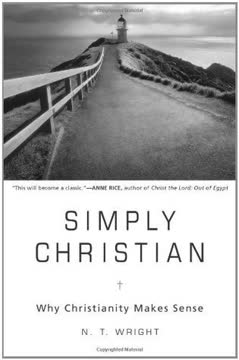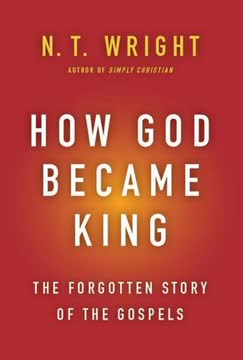Key Takeaways
1. Christian Hope Transcends "Going to Heaven"
As long as we see Christian hope in terms of “going to heaven,” of a salvation that is essentially away from this world, the two questions are bound to appear as unrelated.
Beyond individual salvation. The common perception of Christian hope as simply "going to heaven when you die" is a limited view. The true Christian hope encompasses a much grander vision: the renewal of all creation, a "new heavens and new earth." This perspective connects our ultimate destiny with our present actions and responsibilities.
Two questions intertwined. The book addresses two questions: What is the ultimate Christian hope? What hope is there for change, rescue, transformation, and new possibilities within the world in the present? These questions are often treated separately, but the author argues they are tightly connected.
Surprising hope. The Christian hope is surprisingly different from what many assume. It offers a coherent and energizing basis for work in today's world. This hope is not just about escaping this world but about transforming it.
2. Resurrection: A Jewish Idea Mutated by Christianity
When the early Christians said that Jesus had risen from the dead, they knew they were saying that something had happened to him that had happened to nobody else and that nobody had expected to happen.
Jewish roots, Christian innovation. The early Christian belief in resurrection was firmly rooted in Jewish thought, not paganism. However, early Christians introduced several key modifications to the Jewish understanding of resurrection.
Seven mutations:
- Unanimity of belief
- Centrality of resurrection
- Transformed physicality
- Resurrection split into two (Jesus's and the general resurrection)
- Collaborative eschatology
- New metaphorical use of resurrection
- Association with messiahship
Revolutionary hope. These mutations transformed the Jewish belief in resurrection into a revolutionary hope that energized the early Christian movement. This hope was not merely about individual survival but about the transformation of the entire cosmos.
3. Easter: History, Faith, and a World Transformed
Historical argument alone cannot force anyone to believe that Jesus was raised from the dead, but historical argument is remarkably good at clearing away the undergrowth behind which skepticisms of various sorts have long been hiding.
Eyewitness accounts. The Gospel accounts of Easter, though differing in details, share key features that suggest a genuine historical event. These include the presence of women as primary witnesses, the absence of biblical allusions, and the portrayal of a transformed yet physical Jesus.
Historical evidence. The empty tomb and the encounters with Jesus are the best historical explanation for the rise of Christianity. Alternative explanations, such as cognitive dissonance or spiritual experiences, fail to account for the radical changes in Jewish resurrection belief.
Faith and history. While historical arguments cannot compel belief, they can clear away skepticism and point to the possibility of a transformative event. Faith in Jesus's resurrection transcends but includes historical and scientific knowing.
4. Cosmic Redemption: More Than Individual Salvation
The classic Christian doctrine, therefore, is actually far more powerful and revolutionary than the Platonic one.
Beyond personal salvation. The Christian hope is not limited to individual salvation but extends to the entire cosmos. God's plan is to redeem and renew all of creation, not just to rescue souls from an evil world.
Continuity and discontinuity. The Christian doctrine of resurrection emphasizes both continuity and discontinuity between the present world and the future. What we do in the present matters enormously because it will be transformed and reaffirmed in God's new creation.
Revolutionary doctrine. The robust Jewish and Christian doctrine of the resurrection gives more value, not less, to the present world and to our present bodies. It gives rise not to a meek acquiescence to injustice in the world but to a robust determination to oppose it.
5. Jesus's Ascension: A King's Authority, Not Just a Departure
The ascension demands that we think differently about how the whole cosmos is, so to speak, put together and that we also think differently about the church and about salvation.
Heaven and Earth Intertwined. The ascension of Jesus is not simply his departure from Earth but his enthronement as King of Heaven and Earth. This means that Jesus is both present with us through the Spirit and ruling over all creation.
Relational view of space. The ascension demands a relational view of space, where heaven and earth are not separate locations but interconnected dimensions. Heaven is the control room for Earth, the place from which instructions are given.
Church's role. The church's role is to act as ambassadors of Jesus's kingdom, implementing his authority and transforming the world in accordance with his will. This requires a balance of humility and confidence, recognizing both our limitations and our calling.
6. The Second Coming: Judgment and Hope Intertwined
The English evangelicals gave up believing in the urgent imperative to improve society (such as we find with Wilberforce in the late eighteenth and early nineteenth centuries) about the same time that they gave up believing robustly in resurrection and settled for a disembodied heaven instead.
Beyond Rapture Theology. The second coming of Jesus is not simply about a future rapture or escape from this world. It is about the final unveiling of Jesus's lordship and the establishment of God's justice on Earth.
Judgment and Justice. The second coming involves judgment, but this is not simply about punishment. It is about setting the world right, vindicating the oppressed, and bringing justice to the oppressed.
Present Transformation. The hope of the second coming should inspire us to work for justice and righteousness in the present. We are called to live as citizens of God's kingdom, anticipating the day when his will is done on Earth as it is in Heaven.
7. Bodily Resurrection: The Core of Christian Hope
The early Christian belief in resurrection remains emphatically on the map of first-century Judaism rather than paganism, but from within the Jewish theology of monotheism, election, and eschatology, it opened up a whole new way of seeing history, hope, and hermeneutics.
More than immortality. Bodily resurrection is not simply about the immortality of the soul. It is about the transformation of our entire being, including our physical bodies, into a new and glorious form.
Transformed physicality. The resurrection body will be a transformed body, possessing new properties and capabilities. It will be incorruptible, no longer subject to decay and death.
Model for our future. The resurrection of Jesus serves as the prototype and guarantee of our own future resurrection. We will be raised to new life in bodies like his, sharing in his glory and power.
8. Purgatory, Paradise, and the Communion of Saints
The golden evening brightens in the west; Soon, soon to faithful warriors comes their rest; Sweet is the calm of paradise the blest. Alleluia, Alleluia!
Beyond a three-tiered system. The traditional view of the church divided into triumphant, expectant, and militant is not fully supported by Scripture. All Christians, living and departed, are saints, united in Christ.
Paradise, not purgatory. The Christian dead are in a state of restful happiness, awaiting the final resurrection. There is no biblical basis for the doctrine of purgatory, which suggests a need for further purification after death.
Communion of Saints. We share in the communion of saints with those who have died in Christ. We can pray for and with them, holding them in our love before God.
9. Salvation: Rescue for New Creation, Not Just Escape
If you and I accept the death and resurrection of Jesus as a living, divine, working mechanism in our own lives we shall one day go home to God and find peace.…The Holy Spirit, sent by Jesus himself after his death, offers support and strength for those who call on him.
More than a ticket to heaven. Salvation is not simply about escaping this world and going to heaven when we die. It is about being rescued from the corruption and decay of the present world and being restored to our true humanity.
New Creation. Salvation is about participating in God's new creation, a world of justice, peace, and love. It is about being transformed into agents of God's kingdom, working to bring his will to bear on Earth as it is in Heaven.
Whole-life transformation. Salvation involves the whole person, not just the soul. It involves our bodies, our minds, and our relationships. It is a process of ongoing transformation, as we learn to live in accordance with God's will.
10. Building for the Kingdom: Justice, Beauty, and Evangelism
Therefore, my beloved ones, be steadfast, immovable, always abounding in the work of the Lord, because you know that in the Lord your labour is not in vain.
Justice, beauty, and evangelism. The mission of the church involves three key areas: justice, beauty, and evangelism. These are not separate activities but interconnected aspects of God's kingdom.
Justice. Working for justice involves challenging oppression, advocating for the poor, and seeking to create a more equitable world. It is about reflecting God's righteousness and compassion in our actions.
Beauty. Celebrating beauty involves creating and appreciating art, music, and other forms of creative expression. It is about recognizing the goodness of creation and pointing to the glory of God.
Evangelism. Sharing the gospel involves proclaiming the good news of Jesus Christ and inviting others to join his kingdom. It is about offering forgiveness, hope, and new life to those who are lost and hurting.
11. Reshaping the Church: Mission-Driven, Not Self-Serving
The point is that they were announcing that in Easter “the resurrection from the dead” had actually begun.
Beyond self-preservation. The church must be reshaped to be mission-driven, not self-serving. This means prioritizing the needs of the world over the comfort and convenience of its members.
Biblical priorities. The church must be grounded in Scripture, allowing the Bible to shape its vision and guide its actions. This requires a commitment to studying and interpreting Scripture in its historical and theological context.
Servant leadership. The church must be led by servant leaders who prioritize the needs of others and empower them to participate in mission. This requires humility, compassion, and a willingness to sacrifice personal gain for the sake of the kingdom.
12. Living the Future: Space, Time, Matter, and Spirituality
The world of space, time, and matter is where real people live, where real communities happen, where difficult decisions are taken, where schools and hospitals bear witness to the “now, already” of the gospel while police and prisons bear witness to the “not yet.”
Reclaiming space. The church must reclaim space for worship, prayer, and community. This involves creating sacred spaces that are open and welcoming to all, and that reflect the beauty and glory of God's creation.
Redeeming time. The church must redeem time by celebrating the Christian year, observing the Sabbath, and creating rhythms of work and rest that honor God. This involves prioritizing relationships, reflection, and renewal over productivity and efficiency.
Transforming matter. The church must transform matter through the sacraments, through acts of service, and through responsible stewardship of the Earth's resources. This involves recognizing the goodness of creation and using it to glorify God and bless others.
Last updated:
FAQ
What is Surprised by Hope by N.T. Wright about?
- Rethinking Christian Hope: The book explores the true nature of Christian hope, focusing on resurrection, salvation, and the new creation, challenging common misconceptions about heaven and life after death.
- Present and Future Connection: N.T. Wright connects the ultimate Christian hope with practical implications for life and mission in the present world.
- Mission of the Church: The book emphasizes how a correct understanding of hope shapes the church’s mission, justice, beauty, and evangelism.
- Biblical Vision: Wright presents a biblical vision of new heavens and a new earth, rather than an escapist view of heaven.
Why should I read Surprised by Hope by N.T. Wright?
- Clarifies Misunderstandings: The book addresses widespread confusion about what the Bible teaches regarding heaven, resurrection, and salvation, offering a clear, scripturally grounded explanation.
- Connects Theology and Practice: Wright demonstrates how Christian hope is not escapist but energizes justice, renewal, and mission in the present world.
- Challenges Cultural Assumptions: The book critiques popular but inaccurate views such as “going to heaven when you die” and offers a fresh, hopeful alternative.
- Engages with History and Scripture: Drawing on early Christian beliefs and historical context, Wright provides a robust theological and historical foundation for Christian hope.
What are the key takeaways of Surprised by Hope by N.T. Wright?
- Hope for New Creation: The ultimate Christian hope is not disembodied souls in heaven, but bodily resurrection and the renewal of the whole cosmos.
- Centrality of Resurrection: Jesus’s resurrection is the foundation and prototype for the future resurrection promised to all believers.
- Heaven and Earth United: Heaven is not a distant place but God’s realm that will come down to earth in the new creation.
- Hope Inspires Mission: Christian hope should inspire active engagement in justice, beauty, and evangelism, not withdrawal from the world.
How does N.T. Wright in Surprised by Hope redefine traditional views of heaven and hell?
- Heaven as Renewed Earth: Wright critiques the idea of heaven as a disembodied realm, emphasizing instead the biblical promise of a renewed earth where God’s kingdom is fully realized.
- Hell Reconsidered: He warns against caricatures of hell as eternal conscious torment, suggesting that those who reject God’s love become “creatures that once were human but now are not.”
- Scriptural Caution: Wright notes that the New Testament offers limited explicit teaching on hell and final judgment, urging caution against dogmatic certainty.
How does Surprised by Hope by N.T. Wright explain the resurrection of Jesus and its significance?
- Historical Event: Wright presents the resurrection as a real, historical event with eyewitness testimony, not a myth or metaphor.
- Inauguration of New Creation: Jesus’s resurrection marks the beginning of God’s new creation and the defeat of death and evil.
- Foundation for Hope: The resurrection is the basis for Christian hope in bodily resurrection and the renewal of the cosmos.
- Radical Early Christian Belief: The resurrection redefined Jewish expectations and centered Christian faith on Jesus as Messiah and Lord.
What is the biblical and theological understanding of the “second coming” in Surprised by Hope by N.T. Wright?
- Not Literal Return: Wright argues that Jesus did not explicitly teach a literal second coming; the concept developed from his resurrection and exaltation.
- Parousia as Presence: The Greek word parousia means “presence,” especially royal or divine, not necessarily a physical descent.
- Transformation and Judgment: The second coming is about Jesus’s future personal appearing as judge and king, bringing transformation and renewal, not escape.
- Correcting Misunderstandings: Popular “rapture” theology is a misreading; the focus is on God’s kingdom coming to earth.
How does Surprised by Hope by N.T. Wright describe the nature of the resurrection body?
- Transformed Physicality: The resurrection body will be physical but transformed, incorruptible, and animated by God’s Spirit.
- Continuity and Change: There is both continuity with our current bodies and radical transformation, surpassing present limitations.
- Modelled on Jesus: Jesus’s risen body is the prototype for believers’ future bodies—real and substantial, yet gloriously different.
- Embodied New Creation: The resurrection body enables believers to reign and serve in God’s renewed cosmos.
How does N.T. Wright in Surprised by Hope redefine salvation?
- Salvation as New Creation: Salvation is not just about going to heaven but about being raised to life in God’s new heaven and new earth.
- Present and Future Reality: Christians are “saved in hope,” called to live out salvation now while anticipating its future fulfillment.
- Whole Person and Cosmos: Salvation involves the whole person, not just the soul, and includes participation in God’s mission to renew the entire cosmos.
What does Surprised by Hope by N.T. Wright say about purgatory, paradise, and hell?
- Purgatory as Non-Biblical: Wright explains purgatory as a later Roman Catholic development without clear biblical support.
- Paradise as Restful Waiting: The dead in Christ are in a state of conscious rest and happiness, awaiting resurrection, not a final heaven.
- No Intermediate State Needed: The present life is the time for purification; death itself destroys sinfulness, so no purgatory is needed after death.
- Final Judgment: The final resurrection and judgment will reveal everyone’s ultimate destiny, with no biblical support for souls being helped by departed saints.
How does Surprised by Hope by N.T. Wright connect Christian hope with the mission of the church today?
- Hope Energizes Action: The hope for new creation inspires justice, beauty, and evangelism in the present world, not withdrawal or escapism.
- Kingdom on Earth: The church’s mission is to live and work for God’s kingdom “on earth as it is in heaven.”
- Church as Sign and Foretaste: The church’s worship and life are a sign of the resurrection and a foretaste of the new creation.
- Challenging Cultural Myths: Embracing biblical hope counters both secular progress myths and dualistic escapism.
What role do justice, beauty, and evangelism play in the church’s mission according to Surprised by Hope by N.T. Wright?
- Justice as Setting Right: Christians are called to work for justice now, reflecting God’s kingdom breaking into the present world.
- Beauty as Response: Artistic creativity and appreciation of beauty are vital expressions of new creation, pointing to future restoration.
- Evangelism as Invitation: Evangelism announces God’s kingship and Jesus’s lordship, inviting people into the new creation and a transformed life.
What practical advice does Surprised by Hope by N.T. Wright offer for living as “Easter people”?
- Celebrate Easter Fully: Wright urges churches to celebrate Easter exuberantly, extending the festival beyond one day to embody the joy of resurrection.
- Live Resurrection Now: Christians are called to “wake up” and live as resurrection people, embodying new creation in daily life, ethics, and mission.
- Renew Worship and Mission: The church should reclaim sacred space, time, and matter, integrating worship with active engagement in justice, beauty, and evangelism.
How does Surprised by Hope by N.T. Wright describe Christian spirituality in light of resurrection and new creation?
- Baptism as New Birth: Baptism is the gateway into new creation, symbolizing dying to the old self and rising with Christ to new life.
- Eucharist as Future Present: Communion anticipates the marriage supper of the Lamb, bringing God’s future into the present through bread and wine.
- Prayer and Scripture: Prayer is transformed by intimacy with God through Jesus and the Spirit, while scripture is read as the unfolding story of creation and new creation.
- Holiness and Love: Holiness is living in the new world inaugurated by resurrection, and love is the greatest sign of this new life, shaping present conduct and pointing to our destiny.
Review Summary
Surprised by Hope challenges traditional Christian views on heaven and the afterlife, emphasizing bodily resurrection and the renewal of creation rather than disembodied souls in an ethereal realm. Wright argues that this understanding impacts how Christians live and engage with the world. Readers found the book thought-provoking and life-changing, praising Wright's biblical scholarship and accessible writing style. While some disagreed with specific points, many appreciated the fresh perspective on Christian hope and its implications for justice, beauty, and evangelism. The book's central message resonated deeply with most readers.
Download PDF
Download EPUB
.epub digital book format is ideal for reading ebooks on phones, tablets, and e-readers.










